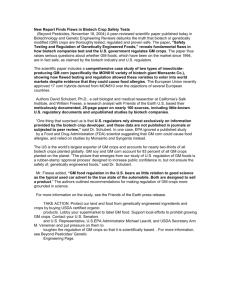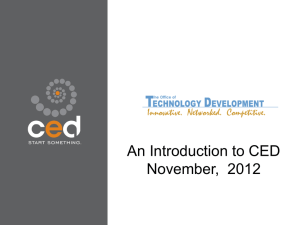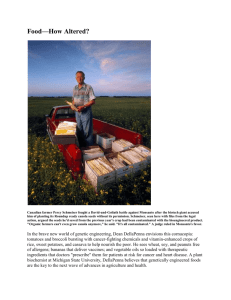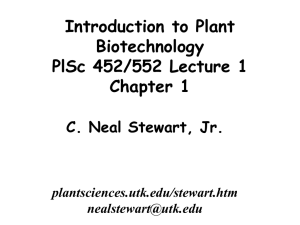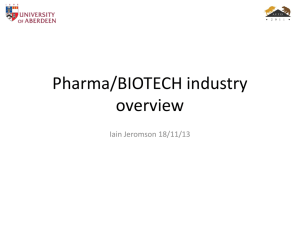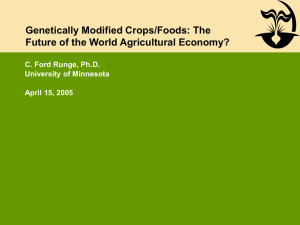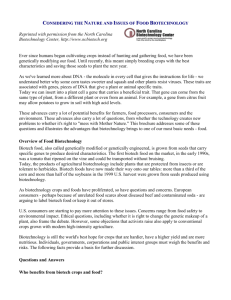US National Academy of Sciences
advertisement
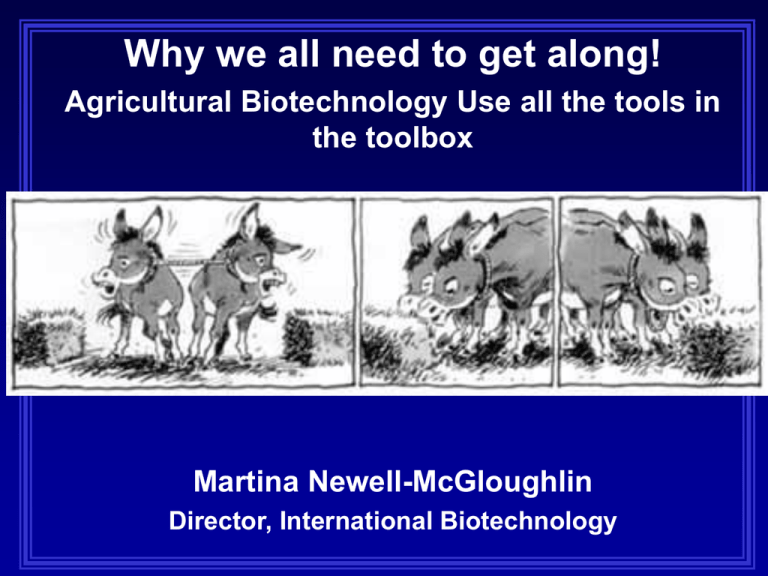
Why we all need to get along! Agricultural Biotechnology Use all the tools in the toolbox Martina Newell-McGloughlin Director, International Biotechnology • • • • 9 Billion mouths to feed by 2050 Will need 70% more food Less water, less fuel, less fertilizer, less pesticides High yielding, affordable, high quality food, feed, fuel, fibre sustainably produced with minimum inputs Food Security • High yielding, affordable, high quality food, feed, fuel, fibre with minimum inputs – 9 B 2050 – need 70% more food • 17% of land under cultivation degraded by human activity 1945 to 1990. Ag land shrinks by 20,000 ha yearly. (World Bank) • Without yield increase land use will 2X by 2050. 1997 acreage • Latin America: greatest yield increase had lower land use (less deforestation) • High yield “land sparing” better than “wildlife”-friendly inefficient land use farming (Green, Royal Soc. Bird Protection 2005) • Biotech is contributing by saving 108.7 million hectares from being converted to ag production (James, 2013). Agriculture: A history of Technology 8,000 BC 19thC Ea 20th C Md 20th C 1930s 1940s 1950s 1970s 1980 1990s 2000s 21st C Cultivation Selective Cross breeding Cell culture Somaclonal variation Embryo rescue Mutagenesis and selection Anther culture Recombinant DNA Marker assisted selection ---omics - Bioinformatics Epigenetics/RNAi/TFs/TALENS Adaptive technology/transgenomics Systems Biology Relative Size of Genomic Introgression by Classical Breeding and Molecular genetics 0 1,000,000 2,000,000 3,000,000 4,000,000 5,000,000 Genome-wide analyses of introgression -oaks to fruit flies - substantial fraction of genomes malleable. Hybridization gives rapid genomic changes, chromosomal rearrangements, genome expansion, differential expression, and gene silencing (transposable elements). Baack 2008 Omic studies Meta-analysis on GM crops using transcriptomic, proteomic and metabolomic profiling techniques show greater variation between conventional bred cultivars and environmental conditions (e.g. drought) than between GM and parental variety (except of course for the intended modification!) Ricroch AE, Bergé JB, & Kuntz M (2011). Wheat (Baker 2006), Potato (Catchpole 2005) Thoroughly regulated • Commercialization: USDA (APHIS), EPA, FDA - 7 to 10 years -at least 9 review stages • Biotech crops and foods more thoroughly tested than conventional varieties ( “assumed” to be safe)One biotech soybean subjected to 1,800 separate analyses • >150 feeding studies - dairy, beef, poultry, soy/corn equivalent in composition, digestibility and feeding value to non-GM. • Substantial equivalence with parent - Molecular characterization (17) Toxicity studies (5) - marker genes (4) - Nutritional content (7+)- Allergenicity potential Anti-nutritional effects - Protein digestibility • Environmental aspects (5 items)- Ecological impact (5 items) • International approval: OECD, CBD, CODEX Thoroughly regulated • Commercialization: 7 to 10 years -at least 9 review stages • Biotech crops and foods more thoroughly tested than conventional varieties ( “assumed” to be safe)- One biotech soybean subjected to 1,800 separate analyses • >150 feeding studies - dairy, beef, poultry, soy/corn equivalent in composition, digestibility and feeding value to non-GM. • Product description (7 items) • Molecular characterization (17 items) • Toxicity studies (as necessary) (5 items) • Antibiotic resistance marker genes (4 items) • Nutritional content (7+ items) • Substantial equivalence with parent variety • Literature review and background • Allergenicity potential • Similarity to natural toxicants • Anti-nutritional effects • Protein digestibility • Environmental aspects (5 items) • Ecological impact (5 items) • An estimated 2 trillion meals containing GM ingredients have been eaten around the world over the last 16 years without a single substantiated case of ill-health. • An overwhelming majority of scientists, medical experts, National Academy of Sciences and over 600 peer-reviewed scientific studies have all concluded that genetically engineered food products are safe. • The World Health Organization has said that: ‘No effects on human health have been shown as a result of the consumption of such foods by the general population.’ • The French Academies of Medicine, Pharmacy & Sciences: “No evidence of health problems exists in the countries where GMOs have been widely eaten for several years” • EU: 25 years of Research 500 research groups over 25 years “There is no scientific evidence associating GMOs with higher risks for the environment or for food and feed safety than conventional plants and organisms” Risk Assessment Precautionary Principle EU Position Changing • On August 27, the United Kingdom Advisory Committee on Releases to the Environment (ACRE) produced three studies examining the structure and basis of the EU regulatory system for crops and foods improved through biotechnology. • Taken together, these reports demonstrate the existing EU regulatory system to be without justification in science, data, or experience. • ACRE concludes that, as presently administered, this regime is counterproductive to reducing or managing risks, and discourages investment and innovation needed to address challenges to sustainable agriculture in the EU. • Furthermore, ACRE states that the assumptions on which these regulations are based are contradicted by the patterns of genetic variation found abundantly in nature, and by the natural processes of genetic exchange and evolution through which they came to pass. EU Position Changing • “There is no substantiated case of any adverse impact on human health, animal health or environmental health, so that’s pretty robust evidence, and I would be confident in saying that there is no more risk in eating GMO food than eating conventionally farmed food,” saying the precautionary principle no longer applies as a result. “GMOs and other scientific advances must be explored in order to head off the increasing scarcity of energy and other resources and competition for land use” • Ann Glover EU Chief Science Advisor, 2013 • 'We believe that GM crops can help make agriculture more efficient and also just as importantly more sustainable, by, for example, reducing the use of pesticides and the use of fossil fuels,' he said. • David Willets Minister of Science UK, 2013 EU ag economy runs on cheap animal feed Imports $15 billion in biotech animal feed each year Livestock production accounts for 40% of the total value of agricultural production Europe is the loser • 2013 Ireland had long harsh winter • Limited fodder • Penalized from asynchronous approval of stacked traits Opportunities/Challenges for Biotech Crops CO2 Value Renewable Resources Biomass conversion, feedstocks, biofuels, Phytoremediation Concerns land/ water use Plants as Factories Pharmaceuticals/ Industrial products (Ventria – Rice Lactoferin Lysozyme 30% Diarrhea, recovery 3/6 days, Concerns gene flow co-mingling Quality Traits Agronomic Traits Biotic Stress - pests/disease/weeds/ Abiotic Stress: Drought, heat, salinity, submergence, marginal soils Yield: nutrient efficiency, fossil genes Improved post harvest characteristics Shelf life, processing, taste Improved Nutrition –Improved Functionality Macro: protein, oils, carbs, fibre Micro: Vitamins, minerals, Phytochemicals – Antioxidants Remove Antinutrients/allergens/ Toxins • • • • • Biotech Crops 2012: 172 million hectares, up 10.2 million - 6% growth US 69.5 Mhas (170Mac), (~90% principal biotech crops) -Canada 8.5MHacs (97.5%) 28 countries (20 LDC) 71% 17.3 M farmers 3.5% -90% (15M) resource-poor LDC Two new Sudan (Bt cotton) and Cuba (Bt maize) – lost Germany Sweden Poland 26% of 420M ac stacked up from 105 M ac or 26% of the 395 M acs in 2011 Source: ISAAA Environmental Impact • Economic gains at the farm level of >$80 B 1996 to 2011 • 1 billion lbs less pesticides • HT Soybean – Conservation Tillage • 93% less soil erosion 31% less wind erosion • Preservation of 1 billion tons of top soil • 70% reduction in herbicide run-off • 80% reduction in phosphorus in water • >50% reduction in fuel use • 50 billion lbs reduction in CO2 emissions • ~10 million cars off the road; saving 270 million acres of land; (Brookes and Barfoot, 2012) Benefits to Date • BT Maize: Cumulative benefits over 14 years $3.2 - $3.6 billion >> $1.9 - $2.4 billion accruing to non-Bt maize growers. Hutchison , 2011 • BT corn 90% reduction in mycotoxin fungal fumonisins - total US benefit estimated at $23m annually (Wu, 2006) • India Bt eggplant reduce insecticide use 40% and double yields • Phytase maize – improved bioavailabilty of P and divalent ions increased nutrition – decreased • PRSV CP papaya saved Hawaii papaya industry (and helped organic farmers!) May be the outcome for plum pox –C5 PTGS insurance against typhoid Mary in nurseries Guess the mystery substances ? Better Alternatives! • Potato Late Blight - Up to 75% of crop can be lost – -Fortuna Resistant potato contains two genes from wild Mexican potato - eliminate fungicide spraying -potential saving $4.3 B – Plus Halo effect! • Grapes- Pierce's disease (X. fastidiosa) - Fusion two genes innate immunity and membrane lysis – preferable to spraying malathion! (Dandekar) • Citrus Greening (C. Liberibacter) – Biotech the only solution 2 spinach genes – showing field R Mirkov 2013 • Apple Fireblight (E. amylovora) – controlled using antibiotic sprays! Cecropin lytic peptide analog (Norelli) • Apple scab (V. inaequalis) Fungicides 'MacIntosh' trees endo- or exochitinase increased resistance • Rootknot nematodes R in tomato (Mi) and (aphids). Alternate to fumigation (Williamson Abiotic stress limiting factor to crops reaching genetic potential Drought tolerant maize ( 30% increase in field trials under H2O stress) Fewer crop losses -Higher yields better water utilization “Resurrection” gene delay droughtinduced leaf loss and stress Submergence sub -1 gene produces 6X grain - save 3 mil tons rice ( save 40 mil people) Salination: Transport protein. Grow and fruit even in irrigation water that is > 50X saltier than normal. > 1/3 seawater. Blumwald and Zhang) Arcadia's Nitrogen Use Efficiency (NUE) plants equivalent yields require 30% less Nitrogen fertilizer greater efficiency Abiotic Stress: Drought, Cold, Heat, Salinity Wild type IPT gene 15 days drought, 7 days re-watered Healthy Potatoes • Reduced asparagine reduces the potential for the formation of acrylamide by 80%, created when potatoes, wheat, coffee, etc cooked at high temperatures. • Reduced black spot from bruising and Browning RNAi suppression of Polyphenol oxidase (PPO) • Reduced sugars which provide potatoes with a consistent golden color, providing ideal taste texture qualities Healthy Oils • High Omega 3 fatty acids – right now fatty fish only source – With biotech soybeans etc can provide a land-based source making it more affordable and accessible! • Also high oleic and high stearate/low saturated soybean oil Golden Rice • Vitamin A is multi-functional • critical component of vision. • plays a significant role in the immune system • crucial for growth and development • It is a disease primarily of poverty, killing 1.9-2.8 million people annually, mostly children under 5 and women. • Golden Rice with genes for bcarotene -200g provides daily requirements to offset deficiency • Cheaper, easier to distribute and more sustainable than other sources Improved Nutritional Content Many common food crops not perfect for nutritional requirements. Proteins: Maize, wheat, Sweet potato and cassava WHO: 800 million people suffer from malnutrition, Protein-energy malnutrition (PEM), the most lethal form, affects 1 in 4 children: 70% live in Asia, 26% Africa, 4% Latin America, Caribbean Functional Foods: benefits beyond basic nutritional needs. Macro: Protein (Better ratio, High lys/ meth, Fossil TF partitioning, artificial) •Carbohydrates (>complex – resistant starch ) •Fats (Higher Oleic (MUFA), Ω-3, Ω- 6 GLA, CLA, MCFA, lower SFA, PUFA •Fibre (low for animals, high for humans (prebiotics, FOS, inulins, lignans) Micro: Vitamins (Golden rice II, Golden Cassava, folate, vit C, vit E), co-factors, minerals (Vine-ripe tomatoes GLK2 TF that controls chloroplast controls sugars/soluble solids, lycopene (Powell) Phytochemicals: anthocyanins carotenoids, flavonoids, isoflavones, isothiocyanates, phenolics (Sirtuins) Anti-nutrients: Trypsin inhibitors, Phytate; caffeine Allergens/intolerance: soy P34, peanut; gluten; Things that may disappear without biotech Papaya • No natural resistance so traditional breeding will not work • Removes viral reservoir thus protects all growers Orange Juice • Citrus Greening – bacterial disease • Spinach genes can save from annihilation Bananas • Fungal, viral & bacterial diseases threatening clonal Cavendish banana – need biotech to save variety Grapes • Pierce's disease spread by glassy wing sharpshooter – • Resistant gene preferable to spraying malathion to control vector Cooperation works Organic Blue Cornfield near yellow non-organic field Fred Yoder Ohio Organic Corn Biotech Corn No cross pollination (no blue kernels) No yellow kernels • Many crops containing diverse market types co-exist: Sweet corn and field corn seed production - Oil and confectionary sunflower seed production- Canola and rapeseed production - Diverse types of rice, cotton, etc\ • Zero-tolerance is extremely difficult to attain. Co-existence is not possible without pragmatic proportional thresholds. Spain and Czech Rep make it work • In the seed industry, the producer seeking higher purity for a higher value product has accepted responsibility for meeting the market expectations • US organics cannot be (legally) downgraded or growers decertified by unintentional presence no producer has been so impacted to date Professional Scientific and/or Medical bodies with an opinion on safety of GMOs Generally Positive The U.S. National Research Council (NRC) U.S. National Academy of Sciences (NAS) The American Medical Association, (AMA) U.S. Department of Agriculture (USDA) U.S. Environmental Protection Agency (EPA) U.S. Food and Drug Administration (FDA) European Food Safety authority (EFSA) American Society for Plant Biology (ASPB) World Health Organization (WHO) Food and Agriculture Organization (FAO) Royal Society (London) Brazil National Academy of Science, Chinese National Academy of Science Indian National Academy of Science Mexican Academy of Science Third World Academy of Sciences Generally Negative I hope that there is nothing genetically modified in this Greatest Challenges going forward • • • • • Technical Intellectual Property: PIPRA - Specialty crops – FTO Liability ( Coexistence – need reasonable thresholds) Regulations: Asynchrony – Lack of uniformity LDCs/ Specialty Acceptance: - countering fear and misinformation (ethical) - moral imperative real need v. hypothetical risk
